Healthy Eating & Physical Activity for Life
- Health Tips for Adults
- Helping Your Child: Tips for Parents & Other Caregivers
- Health Tips for Pregnant Women
- Health Tips for Older Adults
- Clinical Trials
Health Tips for Adults
In this section:
Consuming healthy foods, beverages, and snacks, and getting regular physical activity may help you reach and maintain a healthy body weight. Making suitable lifestyle choices may also help men and women prevent some health problems.

Here’s a quick overview of some ways to eat better and be more active.
- Choose whole grains more often. Try whole-wheat breads and pastas, oatmeal, or brown rice.
- Select a mix of colorful vegetables. Vegetables of different colors provide a variety of nutrients. Try collards, kale, spinach, squash, sweet potatoes, and tomatoes.
- At restaurants, eat only half of your meal and take the rest home.
- Walk in parks, around a track, or in your neighborhood with your family or friends.
- Make getting physical activity a priority.
- Try to do at least 150 minutes a week of moderate-intensity aerobic activity, like biking or brisk walking.
- If your time is limited, work in small amounts of activity throughout your day.
Learn more ways to move more and eat better—for yourself and your family!
Healthy Weight
If it is tough to manage your weight, you are certainly not alone in today’s world. In fact, more than 39 percent of American adults have obesity.1 Excess weight may lead to heart disease, type 2 diabetes, kidney disease, and other chronic health problems. Setting goals to improve your health may help you lower the chances of developing weight-related health problems.
How can you tell if you are at a healthy weight?
Your body mass index (BMI) can help you determine if you are at a healthy weight, overweight, or have obesity. BMI is a measure based on your weight in relation to your height. You can use an online tool to calculate your BMI. A BMI of 18.5 to 24.9 is in the healthy range. A person with a BMI of 25 to 29.9 is considered overweight. Someone with a BMI of 30 or greater is considered to have obesity.
Another important measure is your waist size. Women with a waist size of more than 35 inches, and men with a waist size of more than 40 inches, may be more likely to develop health problems. Men are more likely than women to carry extra weight around their abdomen, or belly. Extra fat, especially in the abdomen, may put people at risk for certain health problems, even if they are not overweight.
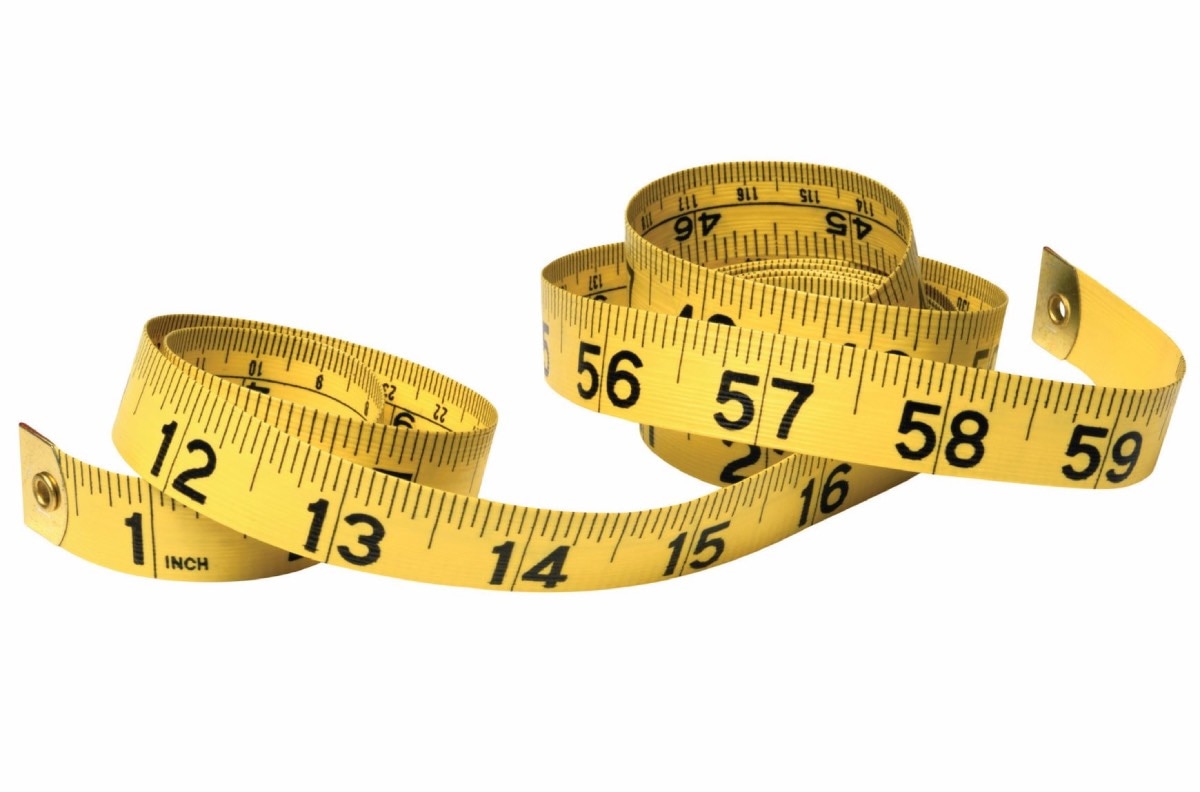
What are some health risks of being overweight or having obesity?
Extra weight may increase your risk for
- type 2 diabetes
- heart disease and stroke
- high blood cholesterol
- high blood pressure
- kidney disease
- fatty liver disease
- problems with pregnancy
- certain types of cancer
Learn the health risks of being overweight or having obesity during pregnancy.
Why do some people become overweight?
Many factors, including consuming more calories than you need from food and beverages, lack of sleep, and low levels of physical activity, may play a part in gaining excess weight. Here are some factors that may influence weight and overall health.
The world around you. Your home, community, and workplace all may affect how you make daily lifestyle choices. Food and beverages high in fat, added sugar, and calories are easy to find and sometimes hard to avoid. And they often cost less than healthier choices like fruits and vegetables. On top of that, smartphones and other devices may make it easy for you to be less active in your daily routine.
Families. Overweight and obesity tend to run in families, suggesting that genes may play a role in weight gain. Families also share food preferences and habits that may affect how much, when, and what we eat and drink.
Medicines. Some medicines, such as steroids, and some drugs for depression and other chronic health problems, may lead to weight gain. Ask your health care professional or pharmacist about whether weight gain is a possible side effect of medicines you are taking and if there are other medicines that can help your health without gaining weight.
Emotions. Sometimes people snack, eat, or drink more when they feel bored, sad, angry, happy, or stressed—even when they are not hungry. Consider whether it might be your emotions making you want to eat, and try doing something else to help you cope with negative feelings or celebrate your good mood. That can help you feel better and avoid weight gain.
Lack of sleep. In general, people who get too little sleep tend to weigh more than those who get enough sleep.2 There are several possible explanations. Sleep-deprived people may be too tired to exercise. They may take in more calories simply because they are awake longer and have more opportunities to eat. Lack of sleep may also disrupt the balance of hormones that control appetite. Researchers have noticed changes in the brains of people who are sleep deprived. These changes may spark a desire for tasty foods.3 Learn more about sleep deprivation and deficiency and strategies for getting enough sleep.
Consuming Healthy Food and Beverages
Being aware of food portion size, the kinds of foods and beverages you consume, and how often you have them may be a step to help you make healthier food choices.
What kinds of foods and drinks should I consume?
Visit MyPlate.gov to learn more about what kinds of food and drinks to consume and what kinds to limit so you can have a healthy eating plan.
Consume more nutrient-rich foods. Nutrients—like vitamins, minerals, and dietary fiber—nourish our bodies by giving them what they need to be healthy. Adults are encouraged to consume some of the following foods and beverages that are rich in nutrients
- fruits and vegetables
- whole grains, like oatmeal, whole-grain bread, and brown rice
- seafood, lean meats, poultry, and eggs
- beans, peas, unsalted nuts, and seeds
- sliced vegetables or baby carrots with hummus
- fat-free or low-fat milk and milk products
If you're sensitive to milk and milk products, try substituting
- nondairy soy, almond, rice, or other drinks with added vitamin D and calcium
- lactose-reduced fat-free or low-fat milk
- dark leafy vegetables like collard greens or kale
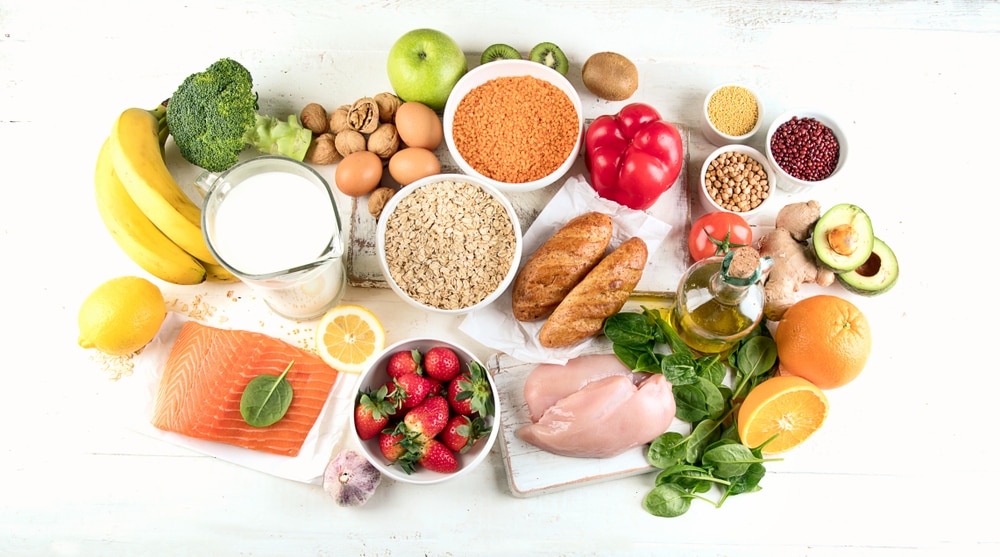
Consume less of these foods and beverages. Some foods and beverages have many calories but few of the essential nutrients your body needs. Added sugars and solid fats pack a lot of calories into food and beverages but provide a limited amount of healthy nutrients. Salt does not contain calories, but it tends to be in high-calorie foods. Adults should aim to limit foods and drinks such as
- sugar-sweetened drinks and foods
- foods with solid fats like butter, margarine, lard, and shortening
- white bread, rice, and pasta that are made from refined grains
- foods with added salt (sodium)
- whole milk
Easy snack ideas. Instead of sugary, fatty snacks, try
- fat-free or low-fat milk or yogurt
- fresh or canned fruit, without added sugars
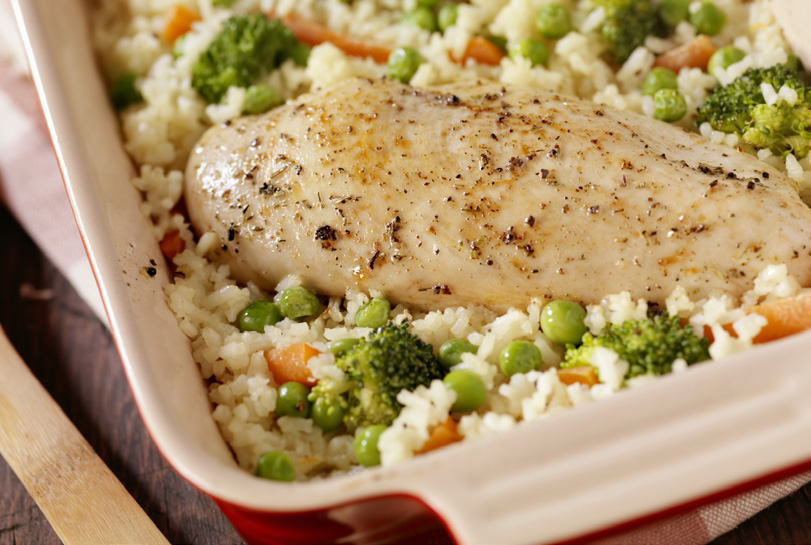 Making better choices, like baking instead of frying chicken, can help you cut down on the added sugars and solid fats you consume.
Making better choices, like baking instead of frying chicken, can help you cut down on the added sugars and solid fats you consume.How can I follow a healthy eating plan?
These tips may help you stay on track with your plan to eat healthier.
- Reduce the overall calories you consume. If you consume more calories than you use through daily living, exercise, and other activities, it may lead to weight gain. If you consume fewer calories than you use through physical activity, it may lead to weight loss.
- Have healthy snacks on hand. Whether you are at home, at work, or on the go, healthy snacks may help combat hunger and prevent overeating. Look for snacks that are low in added sugar and salt. Your best bets are whole foods—like baby carrots, fresh fruit, or low-fat or fat-free yogurt instead of chips, cakes, or cookies—rather than packaged or processed foods.
- Select a mix of colorful vegetables each day. Choose dark, leafy greens—such as spinach, kale, collards, and mustard greens—and red and orange vegetables such as carrots, sweet potatoes, red peppers, and tomatoes. If you have had kidney stones, be aware that some vegetables, like spinach and sweet potatoes, are high in oxalate, a chemical that combines with calcium in urine to form a common type of kidney stone. So, if you have kidney stones, you may need to watch how much of this you eat. But for others, these are great choices. Eat a rainbow of food colors!
- Choose whole grains more often. Try whole-grain breads and pastas, oatmeal, or brown rice.
- Shift from solid fats to oils. Try cooking with vegetable, olive, canola, or peanut oil instead of solid fats such as butter, stick margarine, shortening, lard, or coconut oil. Choose foods that naturally contain oils, such as seafood and nuts, instead of some meat and poultry. And use salad dressings and spreads that are made with oils rather than solid fats.
- Switch from frying to baking or grilling. Instead of fried chicken, try a salad topped with grilled chicken. Instead of ordering fries when eating out, ask for a side of steamed veggies.
- Limit foods and beverages that are high in sugar and salt. Avoid snack foods high in salt and added sugars; and keep away from sugary soft drinks.
- Read the Nutrition Facts label on packaged foods. The Nutrition Facts label tells you how many calories and servings are in a box, package, or can. The label also shows how many ingredients, such as fat, fiber, sodium, and sugar—including added sugars—are in one serving of food. You can use these facts to make healthy food choices.

How much should I consume?
How much you should consume each day depends on your weight, sex, age, metabolism, and how active you are. In general, men need more calories than women. Younger adults need more calories than adults in midlife and older. At all ages, adults who get more physical activity need more calories than those who are less active.
Keeping your food and beverage portions in check may help you reach or stay at a healthy weight. To learn more about a healthy eating plan and the amounts of food and beverages that are right for you, visit MyPlate.gov.
What if I need to lose weight?
Talk with your health care provider about what a healthy weight is for you. If you are overweight or have obesity, your health care professional may recommend weight loss. Consider getting help through a structured weight loss program.
Experts recommend beginning with a weight loss of 5 to 10 percent of your starting weight over a period of 6 months.4 So if you weigh 200 pounds, that would mean losing 10 to 20 pounds. Modest weight loss has been shown to improve health, and it may bring you other benefits such as better mood and more energy.
Use a diary to track the foods and beverages you consume. Keep a food and beverage diary that lists everything you consume in a day. The diary helps you
- see when you are eating a healthy diet and when you might be slipping into less healthy eating (and drinking) patterns
- find out when your eating pattern is most healthy so you can try to do that more often
- discover when and how your diet could use some changes to help you lose weight and improve your health
More adults are using different ways to track health habits, including what and how much they eat and drink, sleep, and weigh. Using apps on mobile phones, tablets, and other devices has become a popular way to track and improve health. These apps have many features. If you are interested, look for apps that best fit your health goals and lifestyle habits.
If you prefer keeping a written diary, check out the sample food and beverage diary below. It includes a section for writing down what the time was and what your feelings were when you consumed the food or beverage. Writing down your feelings may help you identify your eating triggers. For example, you may notice that you sometimes overeat when you are with a big group, simply because everyone around you is consuming large amounts of food and beverages. The next time you share a meal with a group, think about your triggers and try to limit how much you consume by eating more slowly.
Ideas to support your weight-loss efforts. In addition to keeping a diary, focusing on behaviors related to your eating and physical activity level can help jump-start your weight-loss efforts. It can also help you maintain weight loss for the long term. These ideas may help you lose weight.
Consuming food and beverages
- Make a shopping list and stick to it. Don't shop when you are hungry.
- Don't keep foods high in fat, added sugar, or salt in your home, workplace, or car. You can’t consume what’s not there! Keep healthier snacks ready so that you make the healthy choice the easy choice!
- Ask for smaller servings. At a restaurant, consume only half your meal and take the rest home.
- Eat your meals at a table. Turn off the TV and all other devices so you don't mindlessly eat or drink too much. Enjoy your food without distraction.
Behavior
- Be realistic about weight-loss goals. Aim for a slow, modest weight loss.
- Seek support. Include your family and friends.
- Expect setbacks. Forgive yourself if you regain a few pounds. Adjust your plan to help you get back on track.
- Add moderate- or vigorous-intensity physical activity to your weight-loss plan. This kind of activity increases your heart rate and makes you break a sweat. Examples are brisk walking, swimming, and dancing.
Sample Food and Beverage Diary
| Time | Food | Feelings | How I Can Improve |
|---|---|---|---|
| 8 a.m. | Coffee with sugar and cream, oatmeal with low-fat milk, and banana | Hungry. Ate my usual breakfast. | I’ll keep eating breakfast every day and continue choosing whole-grain cereal and milk if I’m ever tempted by a sugary donut or high-fat breakfast sandwich |
| 11 a.m. | Low-fat yogurt | Stomach starting to rumble. | Adding fresh fruit or whole grains will help keep me from overeating later. |
| 12:30 p.m. | Roast beef and cheese sandwich on whole-wheat bread, potato chips, can of soda | Probably ate more than I was hungry for because of the “lunch deal" the deli offered me. | If I pack my lunch, I won't be tempted in the lunch line. Choose water instead of soda. |
| 2:30 p.m. | 1/2 chocolate bar from coworker, large coffee with sugar and cream | Feeling bored, not truly hungry. | Check in with myself to see if I am really hungry. If I am, a snack like veggie slices with salsa or hummus is more nutritious. |
| 7:30 p.m. | Caesar salad, dinner roll, ravioli (didn't finish the whole serving), 1/2 slice of chocolate cake | Out to dinner with friends, so we all ate big portions! We split dessert, which made me feel healthy. | Next time, I'll have a salad with low-fat dressing. Good choice to split the dessert! |
| 10:30 p.m. | Decaf herbal tea | Had trouble falling asleep. Proud of myself for drinking tea rather than eating a snack! | Next time I have trouble falling asleep, I’ll make the same healthy choice! |
Physical Activity
What are the benefits of physical activity?
Experts recommend (PDF, 14.4 MB) that you should move more and sit less throughout the day. You can gain some health benefits if you sit less and do any amount of physical activity. Learn more about the benefits of getting more active.
Keep reminding yourself: Some physical activity is better than none.
Being physically active may help you start feeling better right away. It can help
- boost your mood
- sharpen your focus
- reduce your stress
- improve your sleep
Once you are more active, keep it up with regular activities. That will improve your health even more. Studies suggest that, over time, physical activity can help you live a longer, healthier life. It may
- help prevent heart disease and stroke
- control your blood pressure
- lower your risk of diseases like type 2 diabetes and some cancers
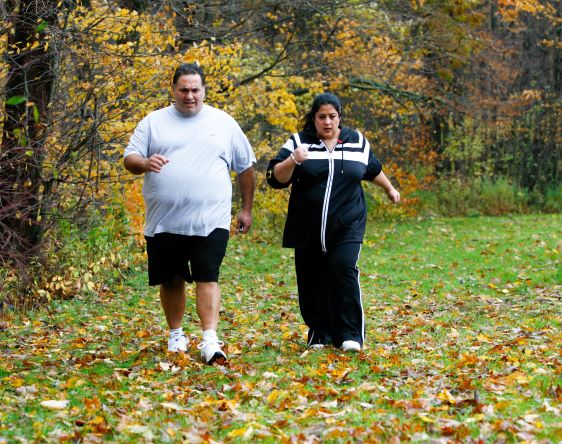
What types of physical activity do I need?
Experts recommend two types of physical activities: aerobic and muscle-strengthening activities.
Aerobic activity. Aerobic activities—also called endurance or cardio activities—use your large muscle groups (chest, legs, and back) to speed up your heart rate and breathing.
Aerobics can be moderate or vigorous. How can you tell what level your activity is? Take the “talk test” to find out. If you’re breathing hard but can still have a conversation easily—but you can’t sing—then you’re doing moderate-intensity activity. If you can only say a few words before pausing for a breath, then you’re at the vigorous level. Start with moderate-intensity activities and then work up to vigorous-intensity activities to avoid injuries.
Choose aerobic activities that are fun for you. You’re more likely to be active if you like what you’re doing. Try getting a friend, family member, or coworker to join you. That may help you enjoy activity and stick with it.
Try one of these activities or any others you enjoy
- brisk walking or jogging
- bicycling (wear a helmet)
- swimming
- dancing
- playing basketball or soccer
Regular aerobic activity can help you
- manage your weight. Aerobic activity uses calories, which may help keep your weight down.
- prevent heart disease and stroke. Regular aerobic activity may strengthen your heart muscle. It may even lower your blood pressure. It may also help lower “bad” cholesterol and raise “good” cholesterol, which may lower your risk of getting heart disease.
- prevent other diseases. Even moderate-intensity aerobic activity each week may lower your risk for type 2 diabetes, some cancers, anxiety, depression, and Alzheimer’s disease and other dementias.
- maintain strong bones. Weight-bearing aerobic activities that involve lifting or pushing your own body weight, such as walking, jogging, or dancing, help to maintain strong bones.
Muscle-strengthening activity. Strength training (or resistance training) works your muscles by making you push or pull against something—a wall or floor, hand-held weights, an exercise bar, exercise bands, or even soup cans.
Try these options
- lift weights—you can even use two full cans of food or gallon-size water containers as weights
- do push-ups, pull-ups, or planks
- work with resistance bands (large rubber bands)
- do heavy gardening (digging, lifting, carrying)
Doing regular activities to strengthen your muscles may help you
- increase bone strength and prevent bone loss as you age
- maintain muscle mass and prevent muscle loss as you age or as you lose weight
- work the major muscle groups of your body, such as the chest, back, abdominals, legs, and arms
How much physical activity do I need?
Experts recommend at least 150 minutes a week (a total of 2 ½ hours) of moderate-intensity aerobic activity. You can spread your activity throughout the week—whatever works best for you. Studies show that if you spread activity across at least 3 days a week, you can improve your health, reduce your risk of injury, and keep yourself from becoming too tired.
If you increase your aerobic activity to 300 minutes a week—instead of the recommended 150 minutes—you may even lower your risk for heart disease or type 2 diabetes. Additionally, if you do more than 300 minutes a week of moderate-intensity aerobic activity, you may even reduce your risk for several cancers.
You should also aim for at least 2 days a week of muscle-strengthening activities. To avoid injury, allow at least 1 day of rest for your muscles to recover and rebuild before working the same muscle groups again.
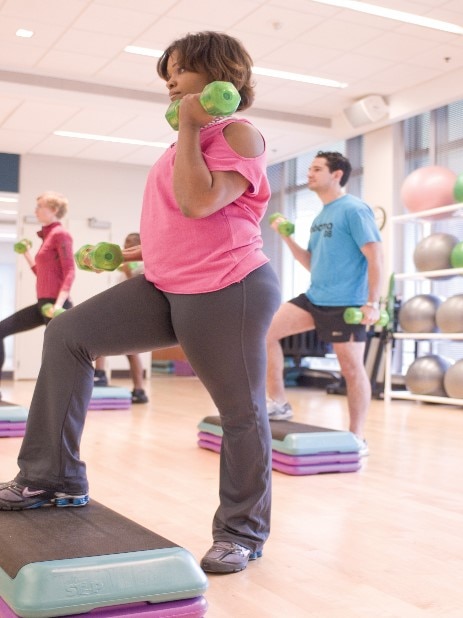
How do I get started?
You don't have to be an athlete to benefit from regular physical activity. Even modest amounts of physical activity can improve your health.
If you have been inactive for a while (PDF, 13.8 MB) , you may want to start with easier activities, such as walking at a gentle pace. For example, you could start by walking 5 minutes at a time, several times a day, 5 to 6 days a week. You could gradually increase your time to 10 minutes per session, 3 times a day, and slowly increase your walking speed. Building up slowly lets you work up to more intense activity without getting hurt.
Be sure to increase your muscle-strengthening activities gradually. Start out 1 day a week at a light or moderate intensity. Over time, increase to 2 days a week, and then possibly to more than 2 days. Increase the intensity until it becomes moderate or greater.
Make a plan to stay on track. You may want to try the Move Your Way interactive activity planner that lets you set your own weekly goals, choose the activities you want to do, and get personalized tips to help you stay motivated.
You can keep an activity log to track your progress, such as the sample log below or an app on your mobile device. After you do an activity, write down how you were feeling while you were active. As you become more fit over time, try to slowly increase your pace, the length of time you are active, and how many days of the week you are active.
Sample Activity Log
| Date | Activity | Total Time | How I Felt |
|---|---|---|---|
| Mon., Mar. 1 | Walking | 2 x 15 minutes | I kept a good pace. |
| Free weights at home | 20 minutes | ||
| Tues., Mar. 2 | Walking | 30 minutes | |
| Stretching | 15 minutes | Stretching felt great. | |
| Wed., Mar. 3 | Extra walking at work—used the stairs 3 times | About 20 minutes total | I was busy, so I just tried to move more all day. |
| Yoga video at home | 20-minute video | Yoga helped me relax. | |
| Thurs., Mar. 4 | Walking | 15 minutes at lunch and 15 minutes after work | Walking with my coworker was fun and relaxing. |
| Fri., Mar. 5 | Walking | 30 minutes at lunch | My coworker and I picked up the pace today! |
| Free weights at home | 20 minutes | ||
| Sat., Mar. 6 | Water aerobics class | 45-minute class | This class is fun but exhausting. |
| Stretching | 15 minutes | ||
| Sun., Mar. 7 | Gardening | 60 minutes | A surprisingly good workout. |
Try these activities to add more movement to your daily life.
- Choose parking spots that are farther away for extra steps. (Make sure the places where you park and walk are safe and well lit.)
- Walk around the inside of a shopping mall or other large building, especially in bad weather.
- Rake the leaves, wash the car, or do brisk housecleaning.
- Visit museums or the zoo. Many of these activities are free. You and your family can walk for hours and not realize how far you have gone.
- Take a break from sitting at the computer, TV, or other device.
- Start a walking or other active group where you work, live, or worship. Having a buddy can help keep you focused and add fun to your activity.
- If your time is limited, do 10 minutes of exercise at a time. Spread these bursts of activity throughout the day. Every little bit counts!
- Plan ahead to avoid setbacks. Find a backup activity you can do in case of bad weather or injury. If you do have a setback, regroup and focus on meeting your goal again as soon as you can.
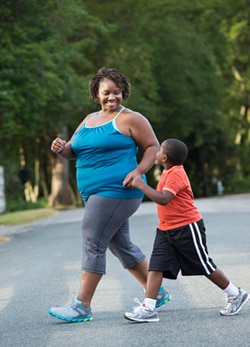 You and your family can walk for hours and not realize how far you have gone.
You and your family can walk for hours and not realize how far you have gone.Being Good to Yourself
Many people feel stress in their daily lives. Stress can cause you to overeat, feel tired, and not want to be active. Healthy eating and regular physical activity may help offset the effects of stress.
Try some of these other ideas to help relieve stress and stay on track with improving your health.
- Get adequate sleep.
- Try a new hobby or any activity that sparks your interest.
- Surround yourself with people whose company you enjoy.
There are apps that give helpful tips on stress management practices and help you monitor the situations that prompt stress. Check them out to see if one works for you.
A balanced eating plan, regular physical activity, stress relief, adequate sleep, and other behaviors may help you stay healthy for life!
References
Helping Your Child: Tips for Parents & Other Caregivers
In this section:
Parents and other caregivers can guide children to develop lifestyle habits that will support their good health for years to come. We know that as a parent or caregiver you may not have all the answers. Like many Americans, you may even struggle to develop and stick with healthy habits of your own. One way to win this double struggle is to practice healthy lifestyle habits—together!
Consuming healthful foods and beverages, doing regular physical activity, getting adequate sleep, and other factors may help children to
- grow
- learn
- build strong bones and muscles
- maintain a healthy weight
- reduce future chances of developing diabetes and heart disease
- feel good about themselves

Healthy Habits
How can I help my child form healthy habits?
As a parent or caregiver, you play a big part in shaping children's eating and drinking habits. When you make it a habit to consume foods and beverages that are low in added sugars, saturated fat, and salt and are high in fiber, the children you care for may learn to like these foods as well. If a child you are caring for does not like a new food right away, don't be upset. Children often need to see a new food many times before they will try it.
Be a role model. As a parent or caregiver, you also have an effect on children's physical activity. You do not need to be an expert at any activity. Just get up, move, and show children how much fun being active can be. They may grow to like it too. You can set a good example by going for a walk or riding a bike instead of watching TV, playing a video game, or surfing the internet. Find an activity that you enjoy and can do together.
Talk about being healthy. As you learn more about how to improve your health, take the time to talk to your children about how a certain food or physical activity may help them. For example, when going for a walk, bring your children with you and let them pick the route. Discuss how walking helps you feel better and is a fun way to spend time together.
Use your children's food and beverage choices as teaching moments. Speak up when you see unhealthy choices. Direct children to healthier options or say, "You can have a little of that, but not too much." Talk to them about why an overly salty or heavily sugared snack is not the best choice. Avoid making them feel guilty about their food or beverage choices. You can also praise your children when they choose a healthy item like fruit.
Use comments like these
- "Great choice!"
- "You're giving your body what it needs with that snack!"
- "I like those, too."

With physical activity, try upbeat phrases like these to keep your child excited
- "You run so fast, I can hardly keep up!"
- "You are building a strong, healthy heart!"
- "Let's walk 10 more minutes to make us stronger."
Make sure your child gets enough sleep. Getting enough sleep can improve your child’s mental, emotional, and physical health. Not getting enough sleep may lead to many health issues, including obesity. Find out how many sleep hours experts recommend for your child, depending on his or her age.
Believe in the power to change. Know that eating healthy and moving more are the building blocks to better health. Work together to form healthy habits.
Promote good health beyond your family. Other adults may play a role in your child's life, too. You can share ideas about healthy habits with them. For instance, many parents and caregivers work outside the home and need others to help with childcare. Family members, day care providers, babysitters, or friends may shape your child's health habits. Talk to them to make sure they offer healthy meals, snacks, and drinks. Check that caregivers are also providing plenty of active playtime and limiting inactive time spent with TV, video games, or other devices.
If your child is in school, you can help promote healthy habits in several other ways
- Find out more about the school's breakfast and lunch programs.
- Find out about the school’s physical education program, and look for opportunities to be active during the school day.

Consider other influences. Just as they do for you, your children's friends and the media can also affect healthy choices.
Some TV, online, and other ads try to persuade children to consume high-fat foods and sugary drinks. You can help your children be aware of these pressures. Speak with your children about choices while you watch TV, surf the internet, or go to the movies with them. Talk about how media outlets and influencers sell products or convey values through famous athletes, child celebrities, cartoon and action figures, and made-up images. Use programs and ads to spark chats about your values. These talks may help your child make healthy choices outside the home.
Healthy Eating
What should my child eat and drink?
Just like adults, children need to consume foods and beverages that are packed with nutrients. Also, like adults, children should consume just enough calories to fuel their daily living and activities. The Dietary Guidelines for Americans, 2020–2025 suggest balancing calories you consume with physical activity. The guidelines also recommend improving eating habits to promote health, reduce the risk of disease, and reduce overweight and obesity. Americans ages 2 years and older are encouraged to consume a variety of healthy foods and beverages. Suggested items include
- fruits, vegetables, unsalted nuts and seeds (please make sure your child can tolerate these foods and isn’t allergic to them), and whole grains
- fat-free or low-fat dairy products, including milk, yogurt, cheese, and/or fortified nondairy beverages
- a variety of protein foods, including seafood, lean meats and poultry, eggs, legumes (beans and peas), nuts, seeds, and soy products
What foods and beverages should be limited?
Youth and adults are also encouraged to get less
- refined grains
- added sugars
- saturated fats, such as lard, butter, and margarine, which are often solid at room temperature
- salt (sodium)
Added sugars, solid fats, and salt often occur in pizzas, chips, crackers, sodas, sugar-sweetened drinks, desserts like cookies or cake, and fast foods. If children and teens consume these foods and beverages, these items should be limited on a healthy eating plan.
Another step is to make sure your children have breakfast to spark the energy they need to focus in school. Some studies suggest that eating breakfast regularly may decrease children’s chances of developing obesity.1

How can I help my child eat better?
Use less fat, salt, and sugar. Here are some ideas to help you and your child follow a healthy eating plan
- Cook with fewer solid fats. Use olive or canola oil instead of butter or margarine. Bake or roast foods instead of frying. You can get a crunchy texture with "oven-frying" recipes that involve little or no oil.
- Choose and prepare foods with less salt. Keep the salt shaker off the table. Have cut-up fruits and vegetables on hand for snacks instead of salty snacks like chips or crackers.
- Limit the amount of sugar your child eats. Choose hot or cold cereals with no added sugar or low sugar.
- Fill half of your child's plate with fruits and vegetables.
- Learn about age-appropriate portion sizes and how to avoid oversized portions.
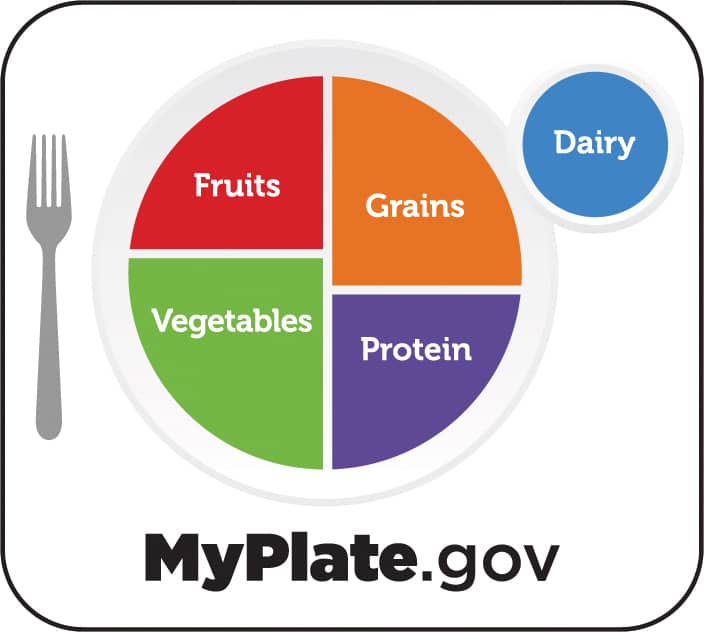
Serve nutrient-rich foods and beverages. Many foods and beverages are particularly rich in key nutrients and vitamins—such as potassium, calcium, vitamin D, and dietary fiber—that are important to your children’s health and development. Here are some ideas for boosting your children's intake of these nutrients
- Offer more fruit for breakfast, snacks, and desserts. Add dark green, red, and orange vegetables to stews and soups. Add beans (black, kidney, pinto), peas, and lentils to casseroles and salads. For meal planning ideas and healthy recipes, see Nutrition.gov.
- Serve more low-fat milk and milk products. If your child cannot digest much lactose, called lactose intolerance, serve lactose-free milk, cheese, or yogurt. (Lactose is the sugar in milk that may cause some people stomach pain and bloating when they drink milk or eat milk products.) Your child can also try nondairy drinks, such as soy, almond, or rice drinks enriched with calcium or vitamin D.
- Serve fresh, frozen, or canned salmon, shrimp, and light tuna (not albacore). For young children, you may serve safe types of seafood (PDF, 378.44 KB) 1–2 times a week in child-sized portions, starting with 1-ounce portions at age 2.2
- Replace the refined grains (breads, pasta, rice) your child eats with whole grains. Eat more bran. Check Nutrition Facts labels to find products high in dietary fiber. Look at the ingredients list to be sure that whole grains are one of the first items.

Think about the drink.
- Serve more water.
- Offer low-fat or fat-free milk instead of whole milk.
- Avoid serving sugar-sweetened beverages and fruit-flavored drinks.
- Offer fresh fruit, which has more fiber than juice. If serving juice, offer small portions of 100% fruit juice.
Offer healthy snacks. Along with their meals, snacks can help children get enough nutrients to help them stay healthy. Buy or prepare single-serving snacks for younger children to help them get just enough to satisfy their hunger. Visit the children's section of ChooseMyPlate to help you and your kids select a satisfying snack.
Try to keep healthy food in the house for snacks and meals for the whole family. Offer such snacks as
- sliced apples, oranges, pears, and carrots
- whole-grain bread served with low-fat cheese, favorite spread, or roasted veggies
- fresh, frozen, or canned vegetables
Keep two more things in mind when choosing healthy snacks.
- Read Nutrition Facts labels to choose the appropriate serving size. Remember that the serving size on nutrition labels applies to adults’ dietary needs and is based on a 2,000-calorie diet. So, the right serving size for most children will probably be smaller than what is on the package, depending on the child’s age, size, and activity level. Visit the parents’ section of Nutrition Facts Label: Read the Label Youth Outreach Materials to find tools for helping your children make healthful food choices and understand how to read the Nutrition Facts label on food packages.
- Children of preschool age and younger can easily choke on foods. Be careful with foods that may be hard to chew, small and round, or sticky. Examples are hard vegetables, whole grapes, hard chunks of cheese, raisins, nuts and seeds, and popcorn. Select snacks with care for children in this age group.
Share food time together. The key word is “together.”
- Plan to have sit-down meals with your children; and serve everyone the same thing.
- Involve your children in planning and preparing meals. Children may be more willing to eat the dishes they help prepare.
- Try to limit how much food or beverages your child consumes on the go and away from home. That will help you control the calories, sugar, and fat your children consume. To serve more homemade meals, cook large batches of soup, stew, or casseroles and freeze them as a time saver. For handy tips on quick and easy homemade meals, visit ChooseMyPlate.gov.
- Limit eating at home to specific areas such as the kitchen or dining room—not in front of a TV or while using another electronic screen.

Physical Activity
How does physical activity help my child?
Experts (PDF, 13.8 MB) suggest that preschool-age children (ages 3 through 5 years) should be physically active throughout the day to help them grow and develop. As a parent or caregiver, you play a big role in helping kids get up and get moving.
If you are caring for preschoolers, try to make sure they get about 3 hours of physical activities each day. Those activities could be light, moderate, or vigorous in intensity. If you are caring for school-age children (ages 6 through 17 years), try to get them to do at least 1 hour of physical activity each day. Experts suggest activities that are moderately or vigorously intense. Bicycling, jumping rope, and playing basketball or soccer are some ways for children to be active.

How can I help my child be more active?
There are many ways you can help.
- As you work to develop a physical activity routine, you can be a role model for your children. If they see you being physically active and having fun, they might grow to like it and stick with it.
- Involve the whole family in activities like dancing or playing a favorite sport.
- Focus on fun. You can do a lot of walking during trips to the zoo or park.
- Include children in family activities like walking the dog, washing the car, or cleaning the house.
- Sign up your children for after-school programs or lessons in an activity or sport they enjoy, if they’re available and you can afford it.
- Team up with your children to play sports or dance video games that get everyone moving.
- Share tips with your children about how to be physically active throughout the day.
- Consider using an interactive online tool to find ways to help your children get more physical activity.
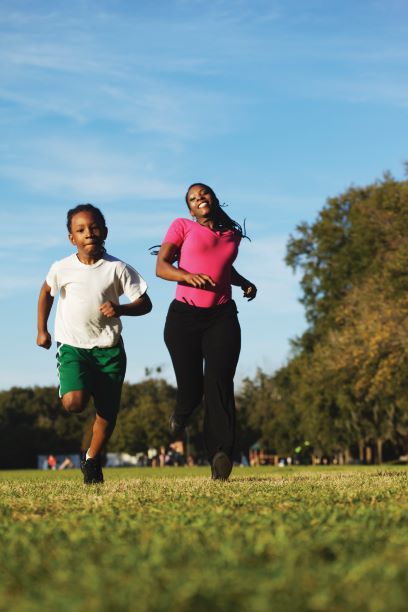
Reduce inactive screen time. Sitting for hours at a time, while using computers, hand-held devices, music players, or TVs, may reduce your child's active playtime.
Pediatricians suggest limiting the time children use digital media outside of homework time. Between ages 2 and 5, allow your children no more than 1 hour of screen time. For children ages 6 and older, set consistent limits on media time. That will help you be sure they have enough time for physical activity, play, sleep, and other healthy behaviors.3,4
Try these tips to reduce your child's screen time
- Do not use screen time to reward your child.
- Set up a family game night and turn off all the screens in your home.
- Eat meals together with no media use. Do not eat in front of a screen.
- Limit time in front of TV or other devices and remove them from your child's bedroom.
- Designate media-free places in your home, such as bedrooms.3,4
What should I do if my child is overweight or has obesity?
Children who are overweight are more likely to become adults who are overweight. These children may develop high blood pressure, type 2 diabetes, and other serious health problems. Weight problems may also lead to stress, sadness, and low self-esteem in children. Because children grow at different rates at different times, it is not always easy to tell if a child is overweight. For example, it is normal for boys to have a growth spurt in weight and catch up in height later.
Ask your health care professional to measure your children and tell you if they are in a healthy range. You can also calculate your child's body mass index (BMI), then discuss any concerns with your child's health care professional. BMI is a measure of body fat calculated from weight and height. If your provider tells you that your child weighs more than he or she should, there are ways you can help your child who is struggling with his or her weight.
How can I help my child with his or her weight?
Here are some do’s and don’ts.
- Accept and love your child at any weight. Doing so will boost self-esteem.
- Involve the whole family in following healthy habits, even if other family members are not overweight.
- Focus on healthy eating, regular physical activity, and adequate sleep, rather than a number on the scale.
- Help your child find ways other than food or beverages to handle setbacks or mark successes.
- Talk with your health care professional to get trusted advice about addressing your child’s health habits and weight. The internet is full of misinformation that may be hard to distinguish from good advice.
Remember, you play the biggest role in your children's lives. You can help your children learn healthy eating, physical activity, and other habits to follow for the rest of their lives.

References
Health Tips for Pregnant Women
In this section:
Having a baby is an exciting time that often inspires women to make healthier lifestyle choices and, if needed, work toward a healthy body weight. Here you’ll find tips on how to improve your eating and physical activity habits while you’re pregnant and after your baby is born.
These tips can also be useful if you’re not pregnant but are thinking about having a baby! By making changes now, you can get used to new lifestyle habits. You’ll give your baby the best possible start on life and be a healthy example to your family for a lifetime.

Healthy Weight
Why is gaining a healthy amount of weight during pregnancy important?
Gaining an appropriate amount of weight during pregnancy helps your baby grow to a healthy size. But gaining too much or too little weight may lead to serious health problems for you and your baby.
According to experts, gaining too much weight during pregnancy raises your chances for developing gestational diabetes (diabetes during pregnancy) and high blood pressure during pregnancy. It also increases your risk for type 2 diabetes and high blood pressure later in life. If you’re overweight or have obesity when you get pregnant, your chances for health problems may be even higher. You could also be more likely to have a cesarean section (C-section).
Gaining a healthy amount of weight helps you have an easier pregnancy and delivery. It may also help make it easier for you to get back to a healthy weight after delivery. Research shows that recommended amounts of weight gain during pregnancy can also lower the chances that you or your child will have obesity and weight-related problems later in life.
How much weight should I gain during my pregnancy?
How much weight you should gain depends on your body mass index (BMI) before pregnancy. BMI is a measure of your weight in relation to your height. You can use a formula to calculate your BMI online.
The general weight-gain advice below is for women having only one baby.
| If you1 | You should gain about |
|---|---|
| Are underweight (BMI less than 18.5) | 28 to 40 pounds |
| Are at a healthy weight (BMI of 18.5 to 24.9) | 25 to 35 pounds |
| Are overweight (BMI of 25 to 29.9) | 15 to 25 pounds |
| Have obesity (BMI of 30+) | 11 to 20 pounds |
It’s important to gain weight very slowly. The old myth that you’re “eating for two” is not true. During the first 3 months, your baby is only the size of a walnut and doesn’t need many extra calories. The following rate of weight gain is advised
- 1 to 4 pounds total in the first 3 months
- 2 to 4 pounds each month from 4 months until delivery
Talk to your health care professional about how much weight gain is appropriate for you. Work with him or her to set goals for your weight gain. Take into account your age, weight, and health. Track your weight at home or when you visit your health care professional.
Don’t try to lose weight if you’re pregnant. Your baby needs to be exposed to healthy foods and low-calorie beverages (particularly water) to grow properly. Some women may lose a small amount of weight at the start of pregnancy. Speak to your health care professional if this happens to you.
Healthy Eating
How much should I eat and drink?
Consuming healthy foods and low-calorie beverages, particularly water, and the appropriate number of calories may help you and your baby gain the proper amount of weight.
How much food and how many calories you need depends on things such as your weight before pregnancy, your age, and how quickly you gain weight. If you’re at a healthy weight, the Centers for Disease Control and Prevention (CDC) says you need no extra calories in your first trimester, about 340 extra calories a day in your second trimester, and about 450 extra calories a day in your third trimester.1 You also may not need extra calories during the final weeks of pregnancy.
Check with your health care professional about your weight gain. If you’re not gaining the weight you need, he or she may advise you to take in more calories. If you’re gaining too much weight, you may need to cut down on calories. Each woman’s needs are different. Your needs also depend on whether you were underweight, overweight, or had obesity before you became pregnant, or if you’re having more than one baby.
What kinds of foods and beverages should I consume?
A healthy eating plan for pregnancy includes nutrient-rich foods and beverages. The Dietary Guidelines for Americans, 2020–2025 recommend these foods and beverages each day
- fruits and vegetables (provide vitamins and fiber)
- whole grains, such as oatmeal, whole-grain bread, and brown rice (provide fiber, B vitamins, and other needed nutrients)
- fat-free or low-fat milk and milk products or nondairy soy, almond, rice, or other drinks with added calcium and vitamin D
- protein from healthy sources, such as beans and peas, eggs, lean meats, seafood that is low in mercury (up to 12 ounces per week), and unsalted nuts and seeds, if you can tolerate them and aren’t allergic to them.
A healthy eating plan also limits salt, solid fats (such as butter, lard, and shortening), and sugar-sweetened drinks and foods.

Does your eating plan measure up? How can you improve your habits? Try consuming fruit like berries or a banana with hot or cold cereal for breakfast; a salad with beans or tofu or other non-meat protein for lunch; and a lean serving of meat, chicken, turkey, or fish and steamed vegetables for dinner. Think about new, healthful foods and beverages you can try. Write down your ideas and share them with your health care professional.
For more about healthy eating, see the MyPlate Daily Checklist. It can help you make an eating plan for each trimester (3 months) of your pregnancy.

What if I’m a vegetarian?
A vegetarian eating plan during pregnancy can be healthy. Consider the quality of your eating plan and talk to your health care professional to make sure you’re getting enough calcium, iron, protein, vitamin B12, vitamin D, and other needed nutrients. Your health care professional may also tell you to take vitamins and minerals that will help you meet your needs.
Do I have any special nutrition needs now that I’m pregnant?
Yes. During pregnancy, you need more vitamins and minerals such as folate, iron, and calcium.
Getting the appropriate amount of folate is very important. Folate, a B vitamin also known as folic acid, may help prevent birth defects. Before pregnancy, you need 400 mcg per day from supplements or fortified foods, in addition to the folate you get naturally from foods and beverages. During pregnancy, you need 600 mcg. While breastfeeding, you need 500 mcg of folate per day.2 Foods high in folate include orange juice, strawberries, spinach, broccoli, beans, fortified breads, and fortified low-sugar breakfast cereals. These foods may even provide 100% of the daily value of folic acid per serving.
Most health care professionals tell women who are pregnant to take a prenatal vitamin every day and consume healthy foods, snacks, and beverages. Ask your doctor about what you should take.
What other new habits may help my weight gain?
Pregnancy can create some new food, beverage, and eating concerns. Meet the needs of your body and be more comfortable with these tips. Check with your health care professional with any concerns.
- Eat breakfast every day. If you feel sick to your stomach in the morning, try dry whole-wheat toast or whole-grain crackers when you first wake up. Eat them even before you get out of bed. Eat the rest of your breakfast (fruit, oatmeal, hot or cold cereal, or other foods) later in the morning.
- Eat high-fiber foods. Eating high-fiber foods, drinking water, and getting daily physical activity may help prevent constipation. Try to eat whole-grain cereals, brown rice, vegetables, fruits, and beans.
- If you have heartburn, eat small meals spread throughout the day. Try to eat slowly and avoid spicy and fatty foods (such as hot peppers or fried chicken). Have drinks between meals instead of with meals. Don’t lie down soon after eating.
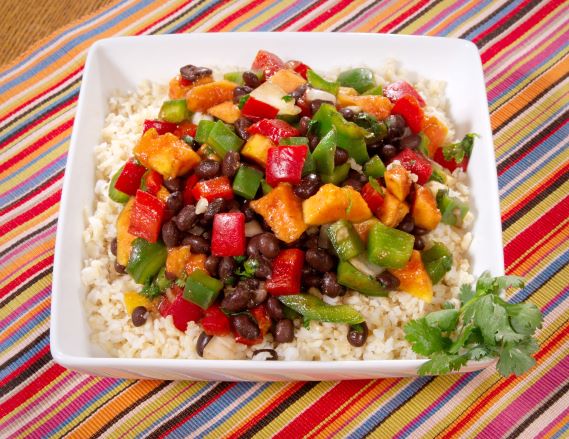
What foods and drinks should I avoid?
Certain foods and drinks can harm your baby if you have them while you’re pregnant. Here’s a list of items you should avoid.
- Alcohol. Do not drink alcohol, such as wine, beer, or hard liquor.
- Caffeine. Enjoy decaf coffee or tea, drinks not sweetened with sugar, or water with a dash of juice. Avoid diet drinks, and limit drinks with caffeine to less than 200 mg per day—the amount in about 12 ounces of coffee.3
- Fish that may have high levels of mercury (a substance that can build up in fish and harm an unborn baby). Limit white (albacore) tuna to 6 ounces per week. Do not eat king mackerel, marlin, orange roughy, shark, swordfish, or tilefish. To get the helpful nutrients in fish and shellfish, you may eat up to 12 ounces of seafood per week, choosing from many safe seafood choices (PDF, 387.44 KB) , such as cod, salmon, and shrimp.3
- Foods that may cause illness in you or your baby (from viruses, parasites, or bacteria such as Listeria or E. coli). Avoid soft cheeses made from unpasteurized or raw milk; raw cookie dough; undercooked meats, eggs, and seafood; and deli salads. Take care in choosing and preparing lunch meats, egg dishes, and meat spreads. See more food safety guidelines during pregnancy.
- Anything that is not food. Some pregnant women may crave something that is not food, such as laundry starch, clay, ashes, or paint chips. This may mean that you’re not getting the right amount of a nutrient. Talk to your health care professional if you crave something that isn’t food. He or she can help you get the right amount of nutrients.
Physical Activity
Should I be physically active during my pregnancy?
Almost all women can and should be physically active during pregnancy. According to current physical activity guidelines (PDF, 14.4 MB) , regular physical activity may
- help you and your baby gain the appropriate amounts of weight
- reduce backaches, leg cramps, and bloating
- reduce your risk for gestational diabetes (diabetes during pregnancy)
- reduce your risk for postpartum depression
There's also some evidence that physical activity may reduce the risk of problems during pregnancy such as preeclampsia (high blood pressure during pregnancy), reduce the length of labor and postpartum recovery, and reduce the risk of having a cesarean section (or C-section).
If you were physically active before you became pregnant, you may not need to change your exercise habits. Talk with your health care professional about how to change your workouts during pregnancy.
Being physically active can be hard if you don’t have childcare for your other children, haven’t exercised before, or don’t know what to do. Keep reading for tips about how you can work around these hurdles and be physically active.

How much and what type of physical activity do I need?
According to current guidelines (PDF, 14.4 MB) , most women need the same amount of physical activity as they did before becoming pregnant. Aim for at least 150 minutes a week of moderate-intensity aerobic activity. Aerobic activities—also called endurance or cardio activities—use large muscle groups (back, chest, and legs) to increase your heart rate and breathing. Brisk walking is a form of aerobic activity.
How can you tell if you’re doing moderate-intensity aerobic activity? Take the “talk test” to find out. If you’re breathing hard but can still have a conversation easily—but you can’t sing—that’s moderate intensity.
If you can only say a few words before pausing for a breath, that’s called vigorous-intensity activity. If you were in the habit of doing vigorous-intensity aerobic activity or were physically active before your pregnancy, then it’s likely okay for you to continue these activities during your pregnancy.
You can talk to your health care professional about whether to or how to adjust your physical activity while you’re pregnant. If you have health issues such as obesity, high blood pressure, diabetes, or anemia (too few healthy red blood cells), ask your health care professional about a level of activity that’s safe for you and your unborn baby.
How can I stay active while pregnant?
Even if you haven’t been active before, you can be active during your pregnancy. Here are some tips.
- Go for a walk where you live, in a local park, or in a shopping mall with a family member or friend. If you already have children, take them with you and make it a family outing.
- Get up and move around at least once an hour if you sit most of the day. When watching TV or sitting at your computer, get up and move around. Even a simple activity like walking in place can help.
- Make a plan to be active while pregnant. List the activities you’d like to do, such as walking or taking a prenatal yoga class. Think of the days and times you could do each activity on your list, such as first thing in the morning, during your lunch break from work, after dinner, or on Saturday afternoon. Look at your calendar or phone or other device to find the days and times that work best and commit to those plans.
How can I stay safe while being active?
For your health and safety, and for your baby’s, you should not do certain physical activities while pregnant. Some of these are listed below. Talk to your health care professional about other physical activities you should not do.
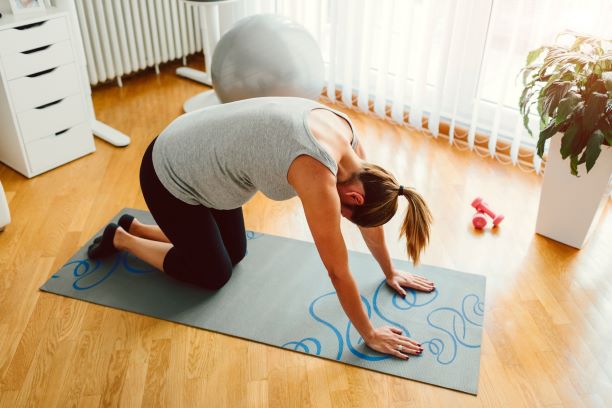
Safety do’s and don’ts
Follow these safety tips while being active.
| Do… | Don’t… |
|---|---|
| Choose moderate activities that aren’t likely to hurt you, such as walking or water or chair aerobics. | Don’t engage in sports where you could fall or injure your abdomen, such as soccer or basketball. |
| Drink fluids before, during, and after being physically active. Don’t overdo it. | Avoid brisk exercise outside during very hot weather. |
| Wear comfortable clothing that fits well and supports and protects your breasts. | Don’t use steam rooms, hot tubs, and saunas. |
| Stop exercising if you feel dizzy, short of breath, tired, or sick to your stomach. | Avoid exercises that call for you to lie flat on your back after week 12 in your pregnancy. |
After the Baby Is Born
How can I stay healthy after my baby is born?
After you deliver your baby, your health may be better if you try to return to a healthy weight slowly. Not losing your “baby weight” may lead to overweight or obesity later in life. Slowly returning to a healthy weight may lower your chances of diabetes, heart disease, and other weight-related problems.
Healthy eating, regular physical activity, adequate sleep, and other healthy habits after your baby is born may help you return to a healthy weight and give you energy.
After your baby is born
- Consume foods and beverages to meet your calorie needs.
- Regular physical activity will continue to benefit your overall health. Moderate-intensity physical activity will increase your fitness and can improve your mood.
Also, physical activity does not appear to have bad effects on how much breast milk is produced, what the breast milk contains, or how much the baby grows.
How may breastfeeding help?
Breastfeeding may or may not make it easier for you to lose weight because your body uses extra calories to produce milk. Even if breastfeeding does not help you lose weight, it’s linked to many other benefits for mother and child.
For mothers who breastfeed, experts advise feeding their babies only breast milk for the first 6 months—no other foods or drinks during this time. Experts suggest that those women continue breastfeeding at least until their baby reaches 12 months.
Calorie needs when you’re breastfeeding depend on how much body fat you have and how active you are. Talk with your health care professional about your calorie needs while you are breastfeeding.
Benefits of breastfeeding. Breastfeeding your baby
- likely gives him or her an appropriate mix of vitamins, minerals, and other important nutrients in a liquid (breast milk) that is easy to digest
- helps boost his or her immune system
- helps protect your baby from common problems, like ear infections and diarrhea

What else may help?
Pregnancy and the time after you deliver your baby can be wonderful, exciting, emotional, stressful, and tiring—all at once. These feelings may cause you to overeat, not get enough calories, or lose your drive and energy. Being good to yourself may help you cope with your feelings and follow healthy lifestyle habits.
Here are some ideas that may help.
- Sleep when the baby sleeps.
- Ask someone you trust to watch your baby while you nap, bathe, read, go for a walk, or go grocery shopping.
- Explore groups that you and your newborn can join, such as “new moms” groups.
- Don’t feel like you need to do it all on your own. Seek help from friends, family members, or local support groups.
Summary of Tips for Pregnancy
- Talk to your health care professional about how much weight you should gain during your pregnancy, and regularly track your progress.
- Consume foods and beverages rich in folate, iron, calcium, and protein. Talk with your health care professional about prenatal supplements (vitamins you may take while pregnant).
- Eat breakfast every day.
- Eat foods high in fiber, and drink fluids (particularly water) to avoid constipation.
- Avoid alcohol, raw or undercooked fish, fish high in mercury, undercooked meat and poultry, and soft cheeses.
- Do moderate-intensity aerobic activity at least 150 minutes a week during your pregnancy. If you have health issues, talk to your health care professional before you begin.
- After pregnancy, slowly get back to your routine of regular, moderate-intensity physical activity.
- Gradually return to a healthy weight.
References
Health Tips for Older Adults
In this section:
As you grow older, you go through many changes, and you may need to adjust your lifestyle for healthy aging. Healthy eating and regular physical activity can be keys to good health at any age. Making suitable lifestyle choices may also prevent some health problems, such as diabetes, heart disease, and some cancers. Health tips include
- Select high-fiber foods like whole-grain breads and cereals, beans, unsalted nuts and seeds, deeply colored vegetables (like green beans), and fruits.
- Avoid fried foods. Choose broiled, grilled, or boiled options instead.
- Drink vitamin D-fortified low-fat or fat-free milk; milk products; or nondairy soy, almond, rice, or other drinks with added vitamin D and calcium to help keep your bones strong as you age.
- Drink fluids throughout the day. You may feel less thirsty as you get older, but your body needs fluids to stay healthy and keep you regular. If you have a bladder control problem, check with your doctor about what, how much, and when to drink liquids.
- Ask your health care professional about whether or how you can safely become active or increase your physical activity.
- Pick physical activities that you enjoy and can do on your own or with a friend or group.
- Stay connected with family, friends, and your community.
Learn what you can do to stay healthy and fit—for yourself and your loved ones!

Healthy Weight
Why is keeping a healthy weight important?
Your body changes as you age. For example, if you are less active, your muscles may not work as well, and that can affect your strength. You may also use fewer calories, especially if you don’t get any physical activity. Over time, if you eat and drink more calories from food or beverages than your body uses from physical activity and daily living, your body may store the extra calories leading to weight gain. Extra weight may lead to overweight or obesity.
Overweight and obesity may increase your risk for
- type 2 diabetes
- heart disease and stroke
- high blood pressure
- high blood cholesterol
- kidney disease
- fatty liver disease
- certain types of cancer
- Alzheimer’s disease and other dementias
What is a healthy weight for me?
Two measures can help you determine whether you are at a healthy weight.
- Body mass index (BMI) is a measure based on your weight in relation to your height. You can use an online tool to calculate your BMI.
Experts recommend that older adults have a BMI between 25 and 27—slightly higher than the recommended range of 18.5 to 24.9 for younger adults. On the other hand, some people, particularly older adults, can have a BMI in the healthy range, but still have too much body fat. That’s why it’s also important to also measure your waist size. - Your waist size is a measure that may tell you if you carry too much body fat. Women with a waist size of more than 35 inches and men with a waist size of more than 40 inches may be more likely to develop health problems.

Being underweight can also be a health concern for older adults. It could mean that you
- have increased risk for weakness and bone loss
- are not eating enough calories to maintain your weight
- don’t have access to enough food or foods that meet your nutrient needs
- have an illness or medical condition
Keeping a healthy weight may help improve your health. The weight that is healthiest for you may be higher than that of a younger person. Ask your health care professional what a healthy weight for you may be.
Healthy Eating
What kinds of foods and drinks do I need to consume as I age?
As you get older, your body begins to need fewer calories, but you need just as many nutrients. So, you will want to focus on eating nutrient-dense foods. Nutrient-dense foods pack a lot of vitamins, minerals, and other nutrients your body needs into a smaller number of calories.
Consume more nutrient-dense foods and beverages. Older adults should "consume foods from the rainbow" because they are rich in nutrients, including
- fruits and vegetables
- whole grains, like oatmeal, whole-grain bread, and brown rice
- fat-free or low-fat milk; milk products; or nondairy soy, almond, rice, or other drinks with added vitamin D and calcium
- seafood, lean meats, poultry, and eggs
- beans, peas, unsalted nuts, and seeds, if you tolerate them and aren’t allergic

Consume less of these foods and drinks. Some foods and drinks have many calories but few of the essential nutrients your body needs. Added sugars, solid fats, and salt—such as those in packaged foods—pack a lot of calories but don’t provide a healthy amount of nutrients. Limit foods and drinks such as
- sugar-sweetened drinks and foods
- foods made with solid fats—butter, lard, margarine, and shortening
- foods high in added fat (such as butter or lard) and salt (sodium)
How can I follow a healthy eating plan?
How much food and drinks you should consume each day depends on your weight, sex, age, metabolism, and how active you are. In general, men need more calories than women. Younger adults need more calories than adults in midlife and older. At all ages, adults who are more physically active may need to consume more calories than those who are less active.
Control portion sizes. A portion is the amount of food or drink you consume in one sitting. Being aware of food portions, serving sizes, and how often you consume them can help you make healthier food and drink choices.
Many people eat more than they need, especially when eating out or getting takeout. Try these tips.
- Remember, restaurants often serve more than one portion. If the portion is bigger than one serving, take home or put away the rest to eat later.
- When eating out or getting takeout, share a meal with a friend or save half of your serving for another meal.
- Avoid watching TV, your smartphone, or other devices while eating. You may not notice how much you are consuming if you’re distracted.
- Consume your food and beverages more slowly and enjoy all the flavors and tastes.
The Nutrition Facts label tells you how many calories and servings are in a box, package, or can. The label also shows how many nutrients, such as fat, protein, carbohydrates, fiber, sodium, and sugar—including added sugars—are in one serving of food. You can use these facts to make healthy food choices. Learn how to read Nutrition Facts labels.
Plan meals and snacks ahead. Consuming healthy meals and snacks may be easier when you plan ahead. Try these tips.
- Cook ahead and freeze food for days when you don't want to cook.
- Keep low-sodium versions of frozen or canned vegetables and beans on hand for quick and healthy meal add-ons.
- Keep frozen or packed-in-juice canned fruits ready for snacks and meals.
- Try to share meals with someone whose company you enjoy.
- If you can't cook for yourself, contact local programs that deliver meals in your area.
- Do not skip meals. Doing so may make you feel hungrier later.

Healthy Eating Tips
Vitamins and minerals are nutrients that help your body stay healthy and work well. Many kinds of vitamins and minerals work together to help you get energy from food. By following a healthy eating plan, you are more likely to get all or most of the vitamins and minerals you need from the food and drink you consume.
Getting enough of vitamins B6, B12, D, and folate is considered important to healthy aging. Talk with your health care professional about the vitamins you need. Based on your eating plan and health status, your health care professional may suggest a supplement to help you get the vitamins and minerals you need. Learn more about vitamin and mineral supplements (PDF, 1.2 MB).
Consuming healthy foods and beverages on a fixed or limited income or budget can be very difficult. Here are some ideas that might help.
- Buy store brands of whole-grain breads, pastas, cereals, and other healthy items.
- Read weekly sales flyers and use coupons or apps to plan healthy meals and snacks at lower prices. Eat what is in season to get the best deals on fresh vegetables and fruits.
- Buy low-sodium versions of canned or frozen vegetables. They are healthy, low-cost, and store well until you need them.
- Apply for the USDA Supplemental Nutrition Assistance Program (SNAP).
- Consider joining food voucher programs sponsored by places of worship or food banks to improve your access to healthy foods and beverages.
Learn more about healthy eating on a budget.
Consuming too much sodium (salt) may lead to health problems, such as high blood pressure, for some.
- Lower your sodium intake to less than 2,300 mg a day (about a teaspoon of salt). That includes sodium added during packaging, cooking, and at the table when eating.
- Read the Nutrition Facts label on foods and beverages to find the sodium content.
- Buy foods and beverages that are low in sodium.
- Limit how much packaged and fast foods and beverages you consume.
- Use less salt when cooking and eating.
- Cook with lemon and spices that have no sodium.
Many factors may affect your ability to eat well and enjoy your meals and snacks, including dental problems, being on a fixed income, and limited ability to move around.
If you don’t have pain in your fingers or hands when writing, try to keep a food diary. Write down all the foods and drinks you have in a day and any concerns you have. Instead of a written diary, consider trying one of the many apps now available on mobile phones, tablets, and other devices. These apps have become a popular way to track and improve health habits, including what and how much you eat and drink, sleep, and weigh. When you visit your health care provider, bring your written or digital food diary and review it together to see if you are getting the nutrients you need.
Your health care professional may recommend that you have different foods and beverages or that you change the number of calories you get each day. He or she may also refer you to a registered dietitian for help with choosing an eating plan that’s right for you.
How can I learn more about how to be healthy as an older adult?
Adults older than age 50 may need different nutrients than younger adults. The National Institute on Aging (NIA) has more information on the foods and beverages older adults should have, including sample menus, tips for grocery shopping, and suggestions for overcoming roadblocks to healthy eating.
Physical Activity
Physical activity is good for your health at every age. If you have never been active, starting regular physical activity now may improve your strength, balance, flexibility, and endurance—being able to move for periods of time without stopping.
Being physically active may help you maintain a healthy weight and avoid chronic health problems as you mature. It may help you reduce symptoms of arthritis, anxiety, and depression. It may help keep diabetes and high blood pressure under control. Being active may also help you live on your own longer by keeping you healthy.
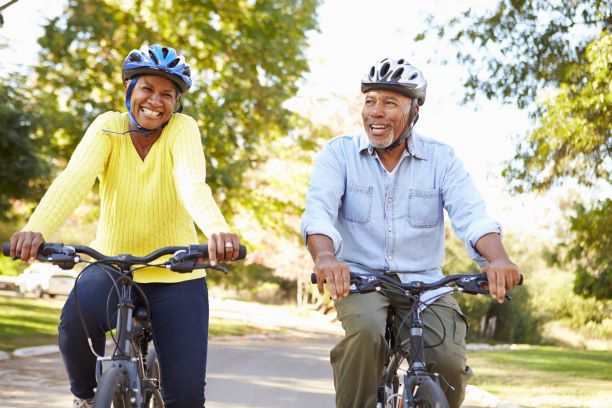
All sorts of activities count—even the things you do anyway, like walking the dog, vacuuming the house, or raking the leaves. Things that don’t feel hard or unpleasant—like dancing or playing jump rope with your grandchild—also count. Learn more about ways to be physically active as you mature (PDF, 1.2 MB).
Being active can be hard if you aren’t able to move around well, use a cane or walker, or have serious health problems. But you can find some activities to help you move more. For example, slowly raising your arms or legs on a regular basis may help you feel more flexible.
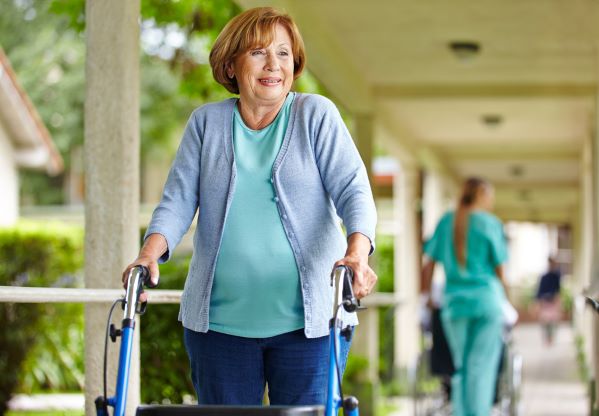
When should I ask my health care professional about being active?
According to the latest research (PDF, 14.4 MB), healthy older adults who plan to increase physical activity a little at a time generally do not need to talk with a health care professional beforehand. However, your health care professional might be able to give you information on types of activities to consider and how to progress at a safe and steady pace.
Do check with your health care professional
- if you are already being treated for a chronic condition, such as type 2 diabetes, heart disease, osteoarthritis, high blood pressure, a physical disability, or are a cancer survivor
- if you have chest pain or pressure, dizziness, or joint pain
- if you want tips to avoid getting hurt
- if you develop new health concerns when increasing your activity level
Your health care professional may recommend and help you plan for the types and amounts of physical activity that will suit you.
How much and what type of physical activity do I need?
Keep in mind that some physical activity is better than none. Aim to keep moving as often as you can.
Healthy older adults should regularly do five types of activities
- aerobic (also called endurance or cardio) activities
- activities to strengthen muscles
- activities to improve balance
- activities to increase flexibility
- activities that combine more than one type of physical activity, such as aerobic, muscle strengthening, and balance training (called “multicomponent” activities)
If you have a serious health problem like diabetes or heart disease, stay aware of how it might limit how much activity you can do safely.
You can divide your activity throughout the day or week—whatever works best for you. Studies show that spreading activity across at least 3 days a week can improve your health, lower your chances of getting hurt, and keep you from feeling tired.
Many activities give you more than just one benefit! Water aerobics with weights give you both aerobic and strengthening benefits. Yoga combines aerobics, balance, flexibility, and strengthening. Choose activities you enjoy.
For any new physical activity, start slowly and work up to your goal. Check out this video for older adults with an exercise routine that you can start at home using everyday objects.
If you have trouble getting started or staying physically active, see some tips to help you overcome roadblocks to becoming more active. To track your progress and stay aware of how you feel while you’re active, you might want to keep an activity log.
Physical Activities
What is aerobic activity?
- Aerobic activity (also called cardio or endurance training) uses your large muscle groups (chest, legs, and back) to speed up your heart rate and breathing.
- Activity is aerobic if you keep it up for some time.
- Moderate-intensity aerobic activity means you can talk but not sing.
- Vigorous-intensity aerobic activity means you cannot say more than a few words without pausing for breath.
Benefits
- Makes your heart, lungs, and blood vessels stronger and more fit
- Increases your endurance
- May lower your risk for heart disease, stroke, diabetes, some cancers, and anxiety
What you can do
- Go for a brisk walk or bike ride. (Remember the helmet.)
- Do housework or gardening.
- Take a yoga, tai chi, water or chair aerobics, or other activities class for older adults. You may find free or discounted classes at a local community or senior center.
How long/how often
- Aim for at least 150 minutes a week of moderate-intensity aerobic activity.
- If you’re doing vigorous-intensity aerobic activity, aim for at least 75 minutes a week.
- Exercise any number of minutes at a time—even climbing up a few flights of stairs counts.
What is muscle-strengthening activity?
- Muscle-strengthening activities make your muscles do more work than they are accustomed to doing.
- These activities can include your legs, hips, chest, back, abdomen (stomach area), shoulders, and arms.
- You can use a moderate or greater level of effort.
Benefits
- Increases your bone and muscle strength
- Helps keep your muscles strong if you’re losing weight
- Improves your balance
What you can do
- Slowly raise and lower arms and legs for several counts. You can even do this while seated.
- Dig in the garden, rake, or push a lawn mower.
- Carry heavy loads, like groceries or laundry.
- Take a class that uses weights and exercise bands.
How long/how often
- Aim for at least 2 days a week.
- No specific amount of time is recommended: just stop when it’s difficult to do another movement.
- Take it slowly: gradually increase the amount of weight, the number of sets or movements, and the number of days a week.
What are balance activities?
- Balance activities require you to keep control of your body as you move.
- They may help strengthen your abdomen (stomach area), chest, lower back, hips, arms, and legs.
Benefits
- Helps you stay steady on your feet
- Reduces the risk of a fall or injury
- Improves your strength at the same time
What you can do
- Try walking heel to toe in a straight line.
- Practice standing on one foot.
- Practice standing from a sitting position.
What are warm-up and cool-down activities?
- Warm-up activities slowly raise your heart rate and cause you to sweat.
- Cool-down activities allow your heart rate and breathing to slow down afterward.
Benefits
- Gets your body ready to move and helps your body to calm down after being active
- Reduces risk of injuries as you get more active
What you can do
- Warm up muscles and joints to be worked with moves, such as arm circles, knee lifts, or brisk walking.
- Cool down muscles and joints that you worked with easy moves such as calf stretches or walk in place.
How long/how often
- Add warm-up and cool-down activities to your regular physical activity efforts.
What are physical activities that give dual health benefits?
- Physical activities that combine both aerobic and muscle-strengthening exercises may offer dual health benefits. Combining activities is especially important for older adults.
- Other activities—such as balance training or daily living physical function training—are also important to include in the mix.
- Programs at your local community or rec center, place of worship, or where you work may offer classes or sessions that include some or all these activities.
- These activities can also be combined at home.
Benefits
- Improves your ability to conduct your daily life with energy and without feeling too tired
- Decreases your risk of falling and getting injured from a fall
- Contributes to your ability to stay independent
What you can do
- Try dancing, yoga, tai chi, gardening, sports, or other recreational activities.
How long/how often
- Add different activities into your regular physical activity program.
- No specific amount of time is recommended.
How can I become more physically active?
- Pick an activity you enjoy and start with small goals, such as “I will take three 10-minute walks this week.”
- “Start low and go slow.” Slowly increase the total amount of time you are active, the number of days you are active, and the intensity of each activity.
- If you live in an assisted-living or retirement facility, ask if the fitness center offers a free health checkup and fitness program.
- Start a walking or other activity group with friends or family members where you live, work, or worship.
Remember to follow these safety tips
- Ask your health care professional about how you can safely increase your physical activity.
- Remember to start slowly and build up to more intense activity over time.
- Wear a sturdy pair of shoes.
- Stop exercising if you have pain, become dizzy, or feel short of breath.
- Drink fluids.
- Do outdoor exercise during daylight hours with a buddy. Be alert when crossing the street.
How can I start or keep up an activity program that works for me?
You can start slowly and increase your goals as you build your endurance and strength over time. For example, you can do arm and leg exercises without weights to get started. As you progress, you can add hand-held weights, like soup cans, to improve your strength.
As you become more fit, try to slowly increase your pace, the length of time you are active, and how many days of the week you are active.
The NIA offers tips on nutrition, exercise, and safety for healthy aging. Try their tips for getting started on an exercise program that works for you.
Being good to yourself
Sometimes older adults feel lonely, sad, low, or stressed because of life changes, loss of loved ones, health problems, caring for other family members, or financial issues. Being good to yourself may help you improve your lifestyle habits, your “get up and go,” and your ability to cope with the demands of daily living.
Here are some ideas for being good to yourself
- Stay in touch with family, friends, or former coworkers to stay engaged and to keep your spirits up.
- See your health care professional regularly and share any concerns.
- Get enough sleep.
- Join a walking group or another social group.
- If you are retired, pursue a new hobby or volunteer to help keep you active and social.
- Surround yourself with people you enjoy.
Remember, it's never too late to improve your eating habits, become more physically active, and be good to yourself for a healthier life!

Talk to your health care professional if you have health concerns
Changes in your home life, health, medicines, income, and sense of smell and taste may affect your interest in consuming healthy food and drinks and physical activity. Perhaps you have had some of these thoughts about eating and exercise.
- The dishes I always liked the most just don't taste the same as they used to.
- Now that I live alone, it's too much trouble to cook for one.
- I don't feel like going to the store because I might slip and fall.
Talk with your health care professional if you
- find it hard to chew or swallow or have trouble with your dentures
- think your medicines make food taste bad or affect your appetite
- think you may need a daily vitamin
- have less interest in eating after the death of a loved one or other life event
- have fears about being active or going outdoors
- have limited funds to shop for food
Clinical Trials
The NIDDK conducts and supports clinical trials in many diseases and conditions, as well as healthy lifestyle-related behaviors, including diet, physical activity, and weight management, among different populations. The trials look to find new ways to prevent, detect, or treat disease and improve quality of life.
What are clinical trials for diet, physical activity, and weight management?
Clinical trials—and other types of clinical studies—are part of medical research and involve people like you. When you volunteer to take part in a clinical study, you help doctors and researchers learn more about diseases and improve health care for people in the future.
Researchers are studying many aspects of diet, physical activity, and weight management, such as
- identifying which people may respond to a specific type of diet
- learning how physical activity improves or maintains weight and overall health
- learning how lifestyle changes may improve weight and health at different ages
Find out if clinical studies are right for you.
Watch a video of NIDDK Director Dr. Griffin P. Rodgers explaining the importance of participating in clinical trials.
What clinical trials for diet, physical activity, and weight management are open?
You can view a filtered list of clinical studies on diet, physical activity, and weight management that are federally funded, open, and recruiting at ClinicalTrials.gov. You can expand or narrow your search to include clinical studies from industry, universities, and individuals; however, the NIH does not review these studies and cannot ensure they are safe. Always talk with your health care professional before you participate in a clinical study.
What have we learned about diet, physical activity, and weight management from NIDDK-funded research?
The NIDDK has supported many research projects to learn more about diet, physical activity, and weight management. For example, recent studies suggest that
- adolescents with severe obesity and type 2 diabetes who receive weight-loss surgery, also called metabolic and bariatric surgery, may have lower blood sugar levels, lose more weight, and benefit in other ways compared with adolescents who receive medical therapy, according to the Teen-Longitudinal Assessment of Bariatric Surgery (Teen-LABS) study.
- adolescents who had weight-loss surgery had remission of diabetes and hypertension (high blood pressure) more often than adults with the same surgery, according to the Teen-LABS study.
- first-time mothers who learned how to respond effectively to their infant’s cues for hunger, sleep, feeding, and other infant behaviors helped improve their children’s body mass index (BMI) scores at 3 years old, according to results of the Intervention Nurses Start Infants Growing on Health Trajectories (INSIGHT) study. Second siblings also benefit from the responsive parenting strategies that their parents had applied with their first-born infants, as measured when the second babies are 1 year old, according to a follow-up study called SIBSIGHT.
- increased glucose levels in pregnant women might be associated with increased infant birth weight, increased levels of serum C-peptide (a substance that shows how much insulin the body is making) in the newborn’s cord, increased risk of cesarean delivery, and clinical hypoglycemia (lower-than-normal blood sugar) in the newborn, according to the Hyperglycemia and Adverse Pregnancy Outcome Follow-Up Study (HAPO-FUS).
This content is provided as a service of the National Institute of Diabetes and Digestive and Kidney Diseases
(NIDDK), part of the National Institutes of Health. NIDDK translates and disseminates research findings to increase knowledge and understanding about health and disease among patients, health professionals, and the public. Content produced by NIDDK is carefully reviewed by NIDDK scientists and other experts.
